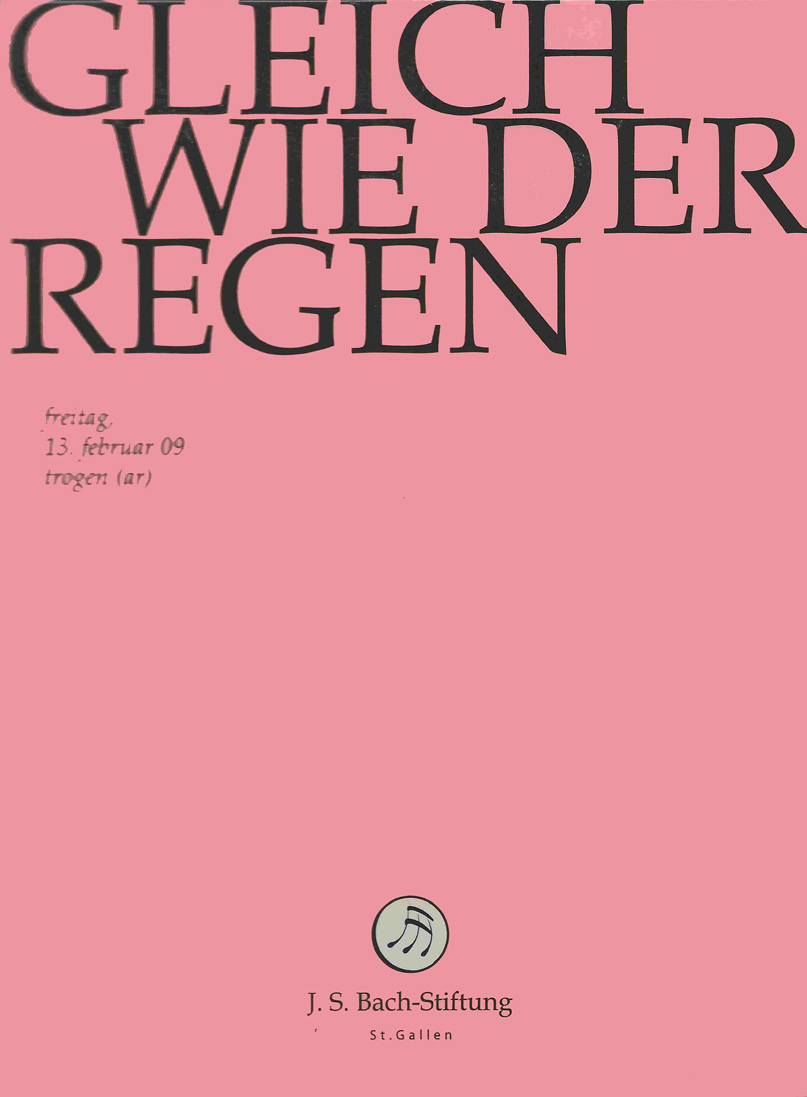Johann Sebastian Bach
Cantata BWV 18, “Gleichwie der Regen und Schnee vom Himmel fällt“
Media Review / Comparison
2012-08-09 — Original posting (on Blogger)
2013-08-01 — New standard layout applied
2014-11-03 — Re-posting as is (WordPress)
2016-06-28 — Brushed up for better readability
Table of Contents
The Media
Ton Koopman, The Amsterdam Baroque Orchestra & Choir
Johann Sebastian Bach: Complete Cantatas, Vol.2
(Cantatas BWV 12, 18, 61, 132, 152, 172, 182, 199, 203; Quodlibet BWV 524)
Ton Koopman, The Amsterdam Baroque Orchestra & Choir
Erato 0630-12598-2 (3 CDs, stereo); ℗ 1995

Rudolf Lutz, J.S.Bach-Stiftung St.Gallen
Johann Sebastian Bach: Cantata “Gleich wie der Regen”, BWV 18
Rudolf Lutz, J.S.Bach-Stiftung St.Gallen (live recording)
J.S.Bach-Stiftung DVD A621 (DVD, stereo 2.0); © 2009

The DVD above is the second sample from the Cantata recordings by Rudolf Lutz and the J.S.Bach-Stiftung St.Gallen, see my Blog entry “Bach, Cantata BWV 140” for more / general comments. I’m comparing this with Ton Koopman’s recording, included in volume 2 from his complete cantata series.
This cantata was almost certainly written in 1713 in Weimar (Sexagesimae); the original version of the cantata just uses four violas and continuo as accompaniment; in 1724, Bach revived the cantata in Leipzig, hereby adding two recorder voices. Both recordings use the Leipzig version, though Koopman also added the Weimar versions of the first and last movement (in the middle movements, the recorders just play colla parte with other voices).
Ton Koopman, Amsterdam Baroque Orchestra & Choir
As with all other cantatas in his complete edition,Ton Koopman is conducting the Amsterdam Baroque Orchestra & Choir, the vocal soloists are Barbara Schlick (soprano), Christoph Prégardien (tenor), and Klaus Mertens (bass). The choir has 17 members (5+4+4+4).
The cantata BWV 18 was recorded in 1995.
1. Sinfonia
Carefully articulated, but somewhat static, less “fluent” than Lutz’ interpretation
3:26 (3:31) — rating: ****
2. Recitativo (bass) “Gleichwie der Regen und Schnee vom Himmel fällt”
Good, not “overcharged”
1:08 — rating: *****
3. Recitativo accompagnato (tenor, bass, choir) “Mein Gott, hier wird mein Herze sein”
The choir could be more dramatic / expressive — it is more (too much?) “well-mannered” than Lutz’ choir. The bass (Klaus Mertens) is much less dramatic (here, it could / should be dramatic!). The real disappointment here is Prégardien: the tempo is too fast, he does not manage the fast, demanding coloraturas, and the continuo also is not well articulated in the fastest passages.
5:03 — rating: ***
4. Aria (soprano) “Mein Seelenschatz ist Gottes Wort”
Compared to Lutz’ / Nuria Rial’s interpretation, this feels much more distant / neutral — and Barbara Schlick’s voice is by no means comparable to Nuria Rial’s in volume, vitality and expression!
2:48 — rating: ***
5. Corale “Ich bitt, o Herr, aus Herzens Grund”
Should be less neutral, static in tempo and phrasing.
1:14 (1:09) — rating: ****
Overall rating
3.8 / 5 (5 tracks)
Rudolf Lutz, J.S.Bach-Stiftung St.Gallen
On the DVD produced by the J.S. Bach Foundation St.Gallen, Rudolf Lutz is conducting the orchestra “schola seconda pratica“, and the “vokalensemble der schola seconda pratica“. He is assisted by the soloists Nuria Rial (soprano), Makoto Sakurada (tenor), and Dominik Wörner (bass). The choir has 14 members (4+4+3+3).
This is a live recording from a concert given on February 13th, 2009.
1. Sinfonia
Compared to Koopman: more presence, more expressive, vivid, more life, attacking, with a faster / fresher tempo — very nice!
2:58 — rating: *****
2. Recitativo (bass) “Gleichwie der Regen und Schnee vom Himmel fällt”
Very large bass voice, good diction — though this recitativo is a bit overcharged: to me, this should be more of an explanatory text introduction to the drama that follows — Dominik Wörner appears to stay in ff, is often coarse in his expression.
1:17 — rating: ****
3. Recitativo accompagnato (tenor, bass, choir) “Mein Gott, hier wird mein Herze sein”
Makoto Sakurada: what a voice: very nice, linear (not too much vibrato), with an excellent “silver lining” (the “ping”, as my vocal teacher used to call it — the ability to activate the resonances in the cavities in the skull), and very touching — the ideal voice for this part! Here now, Dominik Wörner’s dramatic, gross expression is very adequate for the text and the musical / harmonic drama in his part; the only criticism I have is that his singing is a bit short-winded at times. Also the choir is more dramatic than in Koopman’s interpretation. Note that Rudolf Lutz does not push the tempo beyond the abilities of the musicians — but he does take the choral parts slightly faster, in order to allow the choir to be more expressive.
5:35 — rating: ****
4. Aria (soprano) “Mein Seelenschatz ist Gottes Wort”
Listening to Nuria Rial is just as much of a pleasure as in the Cantata BWV 140 (see there for more comments): there’s much more life, her singing is more vivid and more expressive / dramatic than Barbara Schlick’s!
2:52 — rating: *****
5. Corale “Ich bitt, o Herr, aus Herzens Grund”
Expressive, excellent phrasing!
0:54 — rating: *****
Overall rating
4.6 / 5 (5 tracks)
Conclusion:
Once more, the interpretation by Rudolf Lutz and the J.S. Bach Foundation St.Gallen is my clear favorite, as already in the Cantata BWV 140: Koopman’s interpretation falls even more behind in BWV 18 — but OK, this was one of the earliest recordings in Koopman’s cantata collection. The addition of the Weimar version of two movements in the latter interpretation is not much of an advantage — to most listeners, the difference in the listening experience is negligible, if not academic.





